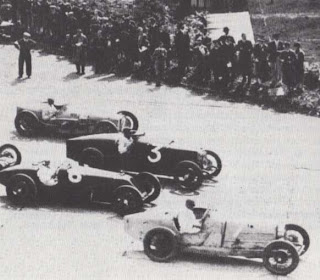
The Formula One series has its roots in the European Grand Prix Motor Racing (q.v. for pre-1947 history) of the 1920s and 1930s. The "formula" is a set of rules which all participants and cars must meet. Formula One was a new formula agreed after World War II in 1946, with the first non-championship races being held that year. A number of Grand Prix racing organisations had laid out rules for a World Championship before the war, but due to the suspension of racing during the conflict, the World Drivers' Championship was not formalised until 1947. The first world championship race was held at Silverstone, United Kingdom in 1950. A championship for constructors followed in 1958. National championships existed in South Africa and the UK in the 1960s and 1970s. Non-championship Formula One races were held for many years but, due to the rising cost of competition, the last of these occurred in 1983.
The sport's title, Formula One, indicates that it is intended to be the most advanced and most competitive of the FIA's racing formula.
The manufacturers' return (2000–2007)
Michael Schumacher and Ferrari won an unprecedented five consecutive drivers’ championships and six consecutive constructors’ championships between 1999 and 2004. Schumacher set many new records, including those for Grand Prix wins (91), wins in a season (13 of 18), and most drivers' championships . Schumacher's championship streak ended on September 25, 2005 when Renault driver Fernando Alonso became Formula One’s youngest champion. In 2006, Renault and Alonso won both titles again. Schumacher retired at the end of 2006 after sixteen years in Formula One.
During this period the championship rules were frequently changed by the FIA with the intention of improving the on-track action and cutting costs. Team orders, legal since the championship started in 1950, were banned in 2002 after several incidents in which teams openly manipulated race results, generating negative publicity, most famously by Ferrari at the 2002 Austrian Grand Prix. Other changes included the qualifying format, the points scoring system, the technical regulations and rules specifying how long engines and tyres must last. A 'tyre war' between suppliers Michelin and Bridgestone saw lap times fall, although at the 2005 United States Grand Prix at Indianapolis seven out of ten teams did not race when their Michelin tyres were deemed unsafe for use. During 2006, Max Mosley outlined a ‘green’ future for Formula One, in which efficient use of energy would become an important factor. And the tyre war ended, as Bridgestone became the sole tyre supplier to Formula One for the 2007 season.
Since 1983, Formula One had been dominated by specialist race teams like Williams, McLaren and Benetton, using engines supplied by large car manufacturers like Mercedes-Benz, Honda, Renault and Ford. Starting in 2000 with Ford’s creation of the largely unsuccessful Jaguar team, new manufacturer-owned teams entered Formula One for the first time since the departure of Alfa Romeo and Renault at the end of 1985. By 2006, the manufacturer teams – Renault, BMW, Toyota, Honda and Ferrari – dominated the championship, taking five of the first six places in the constructors' championship. The sole exception was McLaren, which is part-owned by Mercedes Benz. Through the Grand Prix Manufacturers Association (GPMA) they negotiated a larger share of Formula One’s commercial profit and a greater say in the running of the sport.
Sunday, August 10, 2008
History
Subscribe to:
Post Comments (Atom)

0 Comments:
Post a Comment